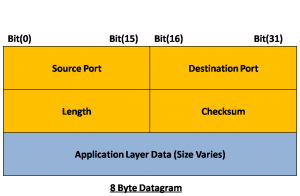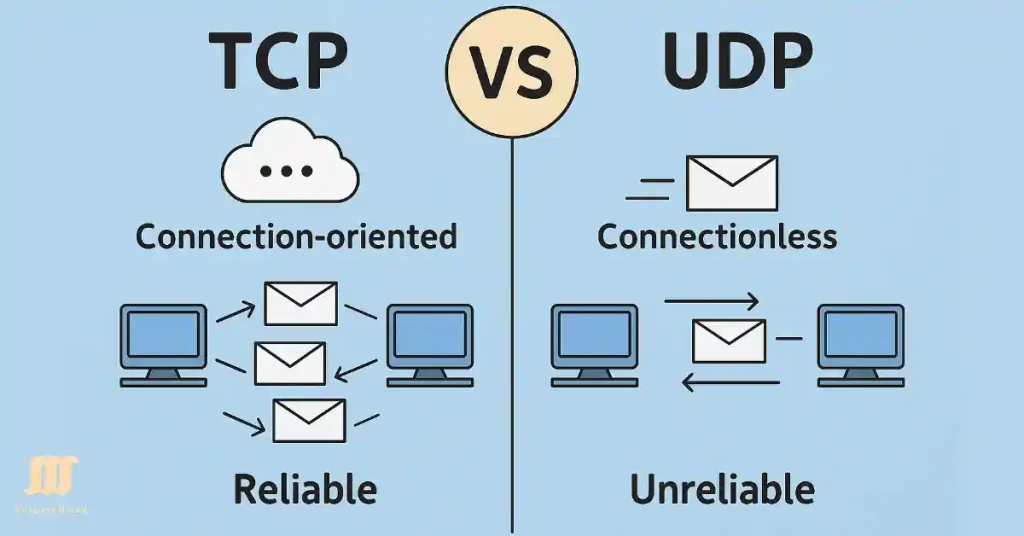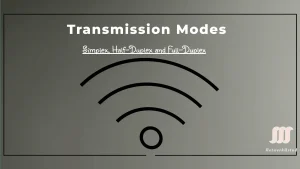The TCP and UDP transport layer protocols handle data communications between terminals in an IP network, with TCP and UDP adapting to 2025’s IoT and 5G demands. The TCP is a connection-oriented protocol, and UDP is a connectionless protocol. TCP powers secure file transfers like banking uploads, while UDP drives live sports streaming, meeting 2025’s diverse network needs.
TCP
Transmission Control Protocol (TCP) tracks packet transmission from source to destination, ensuring 100% delivery. Examples include sending a software file, downloading from a website, and WhatsApp, which uses TCP to confirm message receipt and read status, critical for 2025 communication apps as of July 2025. The TCP has three basic operations:-
- Numbering and tracking segments transmitted to a specific destination from a particular application
- Acknowledging received data
- Retransmitting any unacknowledged data after a certain period
Understanding the difference between UDP and TCP is very important. Understanding the work procedure of each protocol, the implementation of reliability features, and how they track the conversation.
Establishing a Session
TCP is a connection-oriented protocol that negotiates and establishes a permanent session between the source and destination devices before forwarding any data. Throughout the session establishment, the devices check for the amount of traffic that can be sent at a specified time, and the communication data between the two can be closely managed. TCP uses a three-way handshake (SYN, SYN-ACK, ACK) to establish a session. Configure with tcpdump -i eth0 port 80 to monitor, ensuring reliability on July 01, 2025.
Reliable Delivery
A segment can become corrupted or lost as transmitted over the network. The reliability ensures that each sending segment must arrive at the destination. TCP’s overhead increases latency by ~20ms due to reliability, while UDP reduces it to <10ms, ideal for real-time apps, measurable with ping -n 100 192.168.1.10
Same-Order Delivery
Data can arrive in the wrong order due to multiple routes on the network with different transmission rates and speeds. Using numbering and sequencing, TCP ensures the segments are back in the correct order.
Flow Control
The TCP provides flow control between the source and destination hosts. The flow control ensures the data rate at which a sender is transmitting. It ensures the data-sending speed according to the speed of the receiver’s receiving capabilities. It is used to manage the flow of data/packets among two different nodes, especially in cases where the sending device can send data faster than the receiver can take in.
UDP
User Datagram Protocol (UDP) is a connectionless and unreliable protocol. It is not guaranteed to reach its destination. UDP operates without guaranteed delivery, similar to sending a datagram without tracking, suitable for applications tolerating loss as of July 2025.
There is a possibility of loss on the way. The post office is not responsible for tracking the letter or informing the sender if the letter does not arrive at the destination. The User Datagram Protocol works just like the above example.
The User Datagram Protocol provides essential functions for delivering data segments between suitable applications with tiny overhead and data checking. However, the User Datagram Protocol does not acknowledge the receiving data at the destination.
No transport layer processes inform the sender of a successful delivery using UDP. While the TCP reliability functions allow more dynamic communication among applications, they also incur extra overhead and possible transmission delays.
User Datagram Protocol supports multicast for efficient video distribution (e.g., IPTV), using IGMP to join groups, optimizing bandwidth as of 2025.
UDP Features
UDP is a best-effort, lightweight transport protocol that offers the same data segmentation and reassembles as TCP but with no TCP reliability and flow control. The features of UDP are as follows:-
No Ordered Data Reconstruction – Data is reconstructed according to its receiving order.
Unreliable Delivery – Any lost segments, like TCP, have not been resent in this protocol.
Connectionless – No session established with the source and destination.
No Flow Control – Does not inform the sender about the resource availability.
UDP Header
UDP does not inform the source and destination about the packets it receives. It also provides the state of the communication session to the client and server. The UDP application is responsible for reliability and can accept some loss of data during transmission over the network, but transmission delays are unacceptable.
UDP applications, like streaming live audio, video, and VoIP, benefit from low overhead (8-byte header) and best-effort delivery, ideal for 2025 real-time needs as of July 2025. The UDP header, a datagram, is sent without reliability guarantees.

Header Comparison
TCP headers (20-60 bytes) include sequence numbers and ACKs, while UDP headers (8 bytes) contain only source/destination ports and length, impacting efficiency in 2025 networks.
Detailed Congestion Control Mechanisms
TCP’s AIMD adjusts sending rates by increasing linearly and decreasing exponentially during congestion. The leaky bucket algorithm smooths traffic, preventing buffer overflow, crucial for 2025 high-traffic networks.
Error Correction Techniques
TCP uses checksum recalculation and retransmission with ACK/NACK, while UDP relies on application-layer recovery, impacting reliability in 2025 scenarios as of July 2025.
TCP vs UDP Comparison Table
| Feature | TCP | UDP |
|---|---|---|
| Connection Type | Connection-oriented (3-way handshake) | Connectionless |
| Reliability | High (ensures 100% delivery with ACK/NACK) | Low (best-effort, no guarantee) |
| Delivery Order | Guaranteed (segments sequenced) | No order (delivered as received) |
| Flow Control | Yes (sliding window) | No |
| Congestion Control | Yes (AIMD, leaky bucket) | No |
| Header Size | 20-60 bytes (variable) | 8 bytes (fixed) |
| Overhead | Higher (due to control fields) | Lower (minimal fields) |
| Use Cases | Web browsing, file transfer, WhatsApp | Video streaming, VoIP, gaming |
| Latency | Moderate (~20ms overhead) | Low (<10ms overhead) |
| 2025 Relevance | Secure IoT data, 5G control | Real-time IoT, multicast media |
| Troubleshooting | tcpdump -i eth0, netstat -s | ping -n 100, netstat -u |
Note: This comparison reflects 2025 network trends, with TCP optimizing reliability for critical apps and UDP enhancing speed for real-time services.
FAQs
What is the main difference between TCP and UDP
TCP is connection-oriented and reliable, establishing a connection before data transfer and ensuring delivery, while UDP is connectionless and unreliable, sending data without guaranteeing receipt. This makes TCP suitable for applications needing accuracy and UDP for speed.
Why is TCP considered reliable?
TCP ensures reliability by using acknowledgments, retransmissions, and sequencing to confirm data delivery, maintaining order and integrity. It manages flow control and error correction, making it ideal for critical data transfers like web browsing.
When should UDP be used instead of TCP?
UDP is preferred for applications needing speed over reliability, such as streaming or gaming, where occasional data loss is acceptable. Its lack of connection setup reduces latency, making it efficient for real-time communication.
How does TCP handle data loss?
TCP detects data loss through sequence numbers and retransmits lost packets upon receiving no acknowledgment, ensuring all data reaches the destination. This process maintains data integrity but can increase latency.
Can TCP and UDP be used together in a network?
Yes, TCP and UDP can coexist, with different applications using each protocol based on needs, like email with TCP and video streaming with UDP. Networks route traffic accordingly to optimize performance and reliability.





